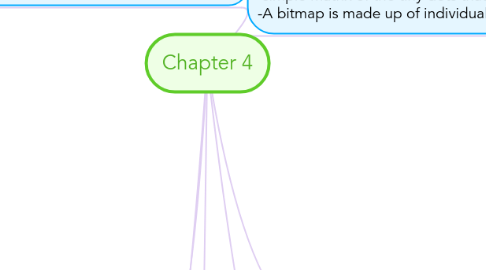
1. Vector-drawn graphics -vector editors are called drawing program
1.1. used in the following area: -Computer-aided design (CAD) programs needed by architects and engineers -Graphic artists designing for the print media -3-D animation programs – changes of position, rotation, and shading of light -Applications requiring drawing of graphic shapes
1.2. Software for vector-drawn graphic: -as Adobe Illustrator can save vector graphics in SVG format
1.3. How work: -A vector is a line that is described by the location of its two endpoints. -Vector drawing makes use of Cartesian coordinates. -Cartesian coordinates are numbers that describe a point in two- or three-dimensional space as the intersection of the X, Y, and Z axes.
1.4. Advantages: -Vector images use less memory space. -For the Web, pages that use vector graphics in plug-ins download faster and, when used for animation, draw faster than bitmaps. -Vector objects are easily scalable without loss of resolution or image quality. -Easy to edit the drawings as each object is independent of the other.
1.5. Disadvantages: -Objects/drawings cannot have texture. -cannot be used for photorealistic images.
2. Before commencing the creation of images in multimedia, you should:
2.1. Plan your approach : Outline project and graphics ideas first – Make a flowcharts and storyboards.
2.2. Organize the available tools : Most authoring systems provide the tools with which can create the graphic objects of multimedia directly on screen.
2.3. Configure computer workspace: Have multiple monitors, if possible, for lots of screen real estate (viewing area)
3. 3-D modeling and rendering
3.1. Tools -Daz3D -Form*Z -NewTek′s Lightwave -Autodesk’s Maya -Trimble’s SketchUp
3.2. Features for 3-D application -Modeling - Placing all the elements into 3-D space. Extrusion - The shape of a plane surface extends some distance. Lathing - A profile of the shape is rotated around a defined axis.
3.3. Rendering: -Use of intricate algorithms to apply user-specified effects
4. Understanding natural light and color models
4.1. Additive color
4.1.1. a color is created by combining colored light sources in three primary colors - red, green, and blue (RGB).
4.2. Subtractive color
4.2.1. -color is created by combining colored media such as paints or ink. -The colored media absorb (or subtract) some parts of the color spectrum of light and reflect the others back to the eye.
4.2.2. - the process used to create color in printing. -The printed page consists of tiny halftone dots of three primary colors: cyan, magenta, and yellow (CMY).
4.3. Dithering
4.3.1. -Dithering is a process whereby the color value of each pixel is changed to the closest matching color value in the target palette.
5. Bitmap -Bitmap editor calling as painting program -derived from the words “bit,” which means the simplest element in digital world -simple matrix of the tiny dots that form an image and are displayed on a screen or printed. -A bitmap is made up of individual dots or picture elements known as pixels or pels.
5.1. suited for creation of: -Photo-realistic images -Complex drawings requiring fine detail
5.2. Advantages -Can have different textures on the drawings; detailed and comprehensive. Disadvantages: -Large file size -Not easy to make modification to objects/drawings -Resizing a bitmapped image requires either duplicating pixels. -Graphics become "blocky" when the size is increased
5.3. Software for bitmap editing and paintng: -Adobe’s Photoshop and Illustrator -Corel’s Painter and CorelDraw
5.3.1. Function and effect can do
5.3.1.1. Morphing effect
5.3.1.2. Making Still Images
5.3.1.3. Distortion effect
5.3.1.4. Image Compositing
5.3.1.5. scan images from conventional sources and make necessary alterations and manipulations.
5.4. Come from: -Capture a bitmap using a camera. -Capture a bitmap from a photo or other artwork using a scanner to digitize the image. -Make a bitmap from scratch with a paint or drawing program -Grab a bitmap from an active computer screen with a screen capture program, then -paste it into a paint program or your applications.
6. Texture
6.1. refers to the properties held and sensations caused by the external surface of objects received through the sense of touch.
7. Image File Types Used in Multimedia
7.1. Macintosh formats: -the most commonly used format is PICT. -PICT is a versatile format developed by Apple.
7.2. Windows formats: -The most commonly used image file format on Windows is DIB, also known as BMP. -DIB stands for device-independent bitmaps.
7.3. Cross-platform formats:
7.3.1. JPEG(Joint Photographic Expert Group ) -Commonly used standard method of compression for photographic images. -Support a maximum of 16.7 million colors -Lossy compression technique: Losses some image information. -Degradation of image possible with repeated editing and saving -No transparency -No animation
7.3.2. GIF: -8-bit per pixel, bitmap image format commonly used by the world wide web. -Uses lossless compression technique. -Image can have transparent portion. -Animation possible.
7.3.3. PNG (Portable Network Graphic ): -Supports more than 16.7 million colors. -Use Lossless Compression Technique -Image can have transparent portion -No animation
7.4. Image File Compression
7.4.1. Lossy compression -reduces a file by permanently eliminating certain information, especially redundant information.
7.4.2. lossless compression: -every single bit of data that was originally in the file remains after the file is uncompressed. All of the information is completely restored

